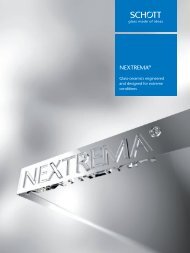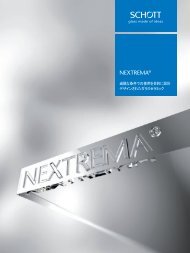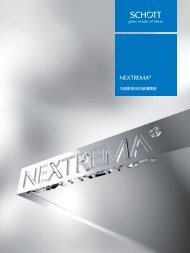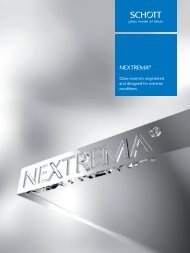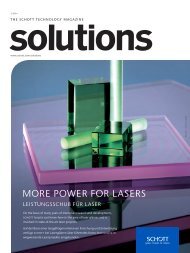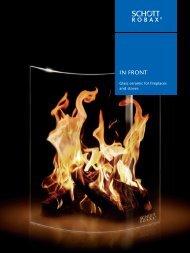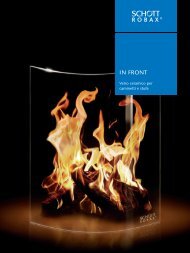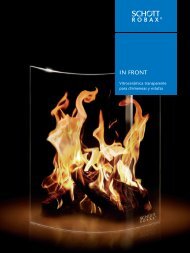SCHOTT Technical Glasses
Apart from its application in optics, glass as a technical material has exerted a formative influence on the development of important technological fields such as chemistry, pharmaceutics, automotive, optics, optoelectronics and information technology. SCHOTT Technical Glasses offers pertinent information in concise form. It contains general information for the determination and evaluation of important glass properties and also informs about specific chemical and physical characteristics and possible applications of the commercial technical glasses produced by SCHOTT. With this brochure, we hope to assist scientists, engineers, and designers in making the appropriate choice and make optimum use of SCHOTT products.
Apart from its application in optics, glass as a technical material has exerted a formative influence on the development of important technological fields such as chemistry, pharmaceutics, automotive, optics, optoelectronics and information technology. SCHOTT Technical Glasses offers pertinent information in concise form. It contains general information for the determination and evaluation of important glass properties and also informs about specific chemical and physical characteristics and possible applications of the commercial technical glasses produced by SCHOTT. With this brochure, we hope to assist scientists, engineers, and designers in making the appropriate choice and make optimum use of SCHOTT products.
Create successful ePaper yourself
Turn your PDF publications into a flip-book with our unique Google optimized e-Paper software.
12<br />
2.3 The significance of chemical stability<br />
2.3.1 Corrosion resistance in chemical plant applications<br />
For such applications, the glasses must be resistant to the<br />
various chemical solutions to such a degree that manifold<br />
reactions can take place without running the risk of damaging<br />
the laboratory glass or the equipment by strong ablation.<br />
Moreover, no interfering amounts of glass components<br />
must be released into the reaction mixture. Attack by acids<br />
is of particular importance, both in laboratories and in chemical<br />
technology. Here, borosilicate glasses with their high<br />
acid resistance are superior to other materials. Up to the<br />
boiling point, their reactivity is very low; it then increases<br />
with increasing acid concentration, but decreases again at<br />
higher concentrations (Figure 3). The alkali attack, in contrast,<br />
increases exponentially with increasing alkali concentration<br />
(Figure 2).<br />
A comparison of the effect of the alkaline mixture (concentration<br />
of alkaline components about 1 mol/l) with the effect<br />
of 6 mol/l hydrochloric acid (the most aggressive acid used<br />
in acid resistance tests) under standard conditions shows<br />
that the alkali attack increases by a factor of 1000 after extended<br />
exposure.<br />
2.3.2 Release of glass constituents<br />
In various processes of chemical technology, pharmaceuticals,<br />
and laboratory work, the material glass is expected to<br />
release no constituents (or a very minimum) into the reacting<br />
solutions or stored specimens.<br />
Production of floated borosilicate glass






